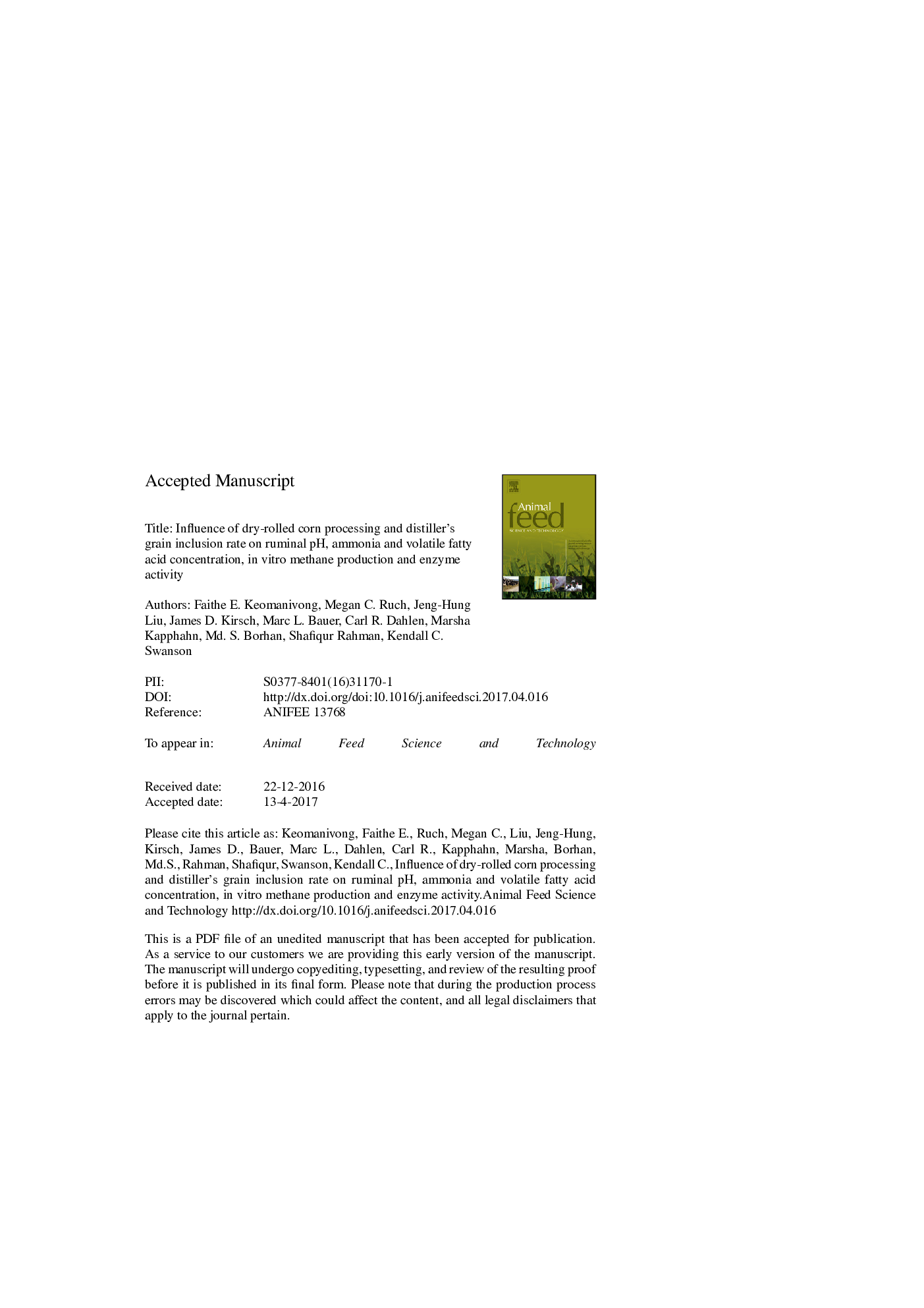| Article ID | Journal | Published Year | Pages | File Type |
|---|---|---|---|---|
| 5538911 | Animal Feed Science and Technology | 2017 | 29 Pages |
Abstract
The objective was to determine the effects of degree of dry-rolled corn processing and dried distiller's grains with solubles (DDGS) inclusion rate on ruminal pH, NH3 and volatile fatty acid (VFA) concentration, total in vitro gas and methane production, and enzyme activity in cattle fed high-concentrate diets. Eight ruminally cannulated Holstein steers (526 ± 3.6 kg) were randomly assigned to four dietary treatments in a 2 Ã 2 factorial arrangement consisting of 1) 650 g/kg coarse-rolled corn (2.5 ± 0.008 mm) with 200 g/kg DDGS, 2) 450 g/kg coarse-rolled corn with 400 g/kg DDGS, 3) 650 g/kg fine-rolled corn (1.7 ± 0.002 mm) with 200 g/kg DDGS and 4) 450 g/kg fine-rolled corn with 400 g/kg DDGS. Diets met NRC recommendations and were offered for ad libitum intake. The experimental design was a 4 Ã 4 Latin square with 17-d periods allowing for 7 d of diet adaptation, 7 d of sample collection, and 3 d of rest in which all steers were offered an intermediate ration. There were no differences in ruminal pH among treatments. However, steers consuming 400 g/kg DDGS tended (P = 0.07) to have a pH less than 5.5 for a longer period of time (h/d) than those consuming 200 g/kg DDGS. Ruminal NH3 was greater in steers receiving 200 g/kg DDGS (P = 0.02). Steers fed fine-rolled corn had greater (P = 0.02) concentrations of butyric acid while those consuming coarse-rolled corn tended (P = 0.06) to have greater concentrations of isovaleric acid. No difference in DM degradation rate was noted between treatments. In vitro methane concentration of the headspace was unaffected by treatment. Steers fed diets containing 200 g/kg DDGS had greater (P < 0.001) ruminal α-amylase activity (U/L ruminal fluid; U/L/kg starch disappearance) while those fed 400 g/kg DDGS had greater (P = 0.01) trypsin activity (U/L/kg CP disappearance). An interaction between degree of corn processing Ã DDGS was noted for measurements of trypsin activity (U/L/kg CP disappearance; P = 0.02) and maltase (U/L of ruminal fluid; P = 0.004). In conclusion, the results are likely the result of the final nutrient profile of each treatment. Overall, there were minimal effects on ruminal fermentation and in vitro methane concentration with increasing degree of dry-rolling or DDGS inclusion indicating limited effects on ruminal health and environmental sustainability.
Related Topics
Life Sciences
Agricultural and Biological Sciences
Animal Science and Zoology
Authors
Faithe E. Keomanivong, Megan C. Ruch, Jeng-Hung Liu, James D. Kirsch, Marc L. Bauer, Carl R. Dahlen, Marsha Kapphahn, Md. S. Borhan, Shafiqur Rahman, Kendall C. Swanson,
